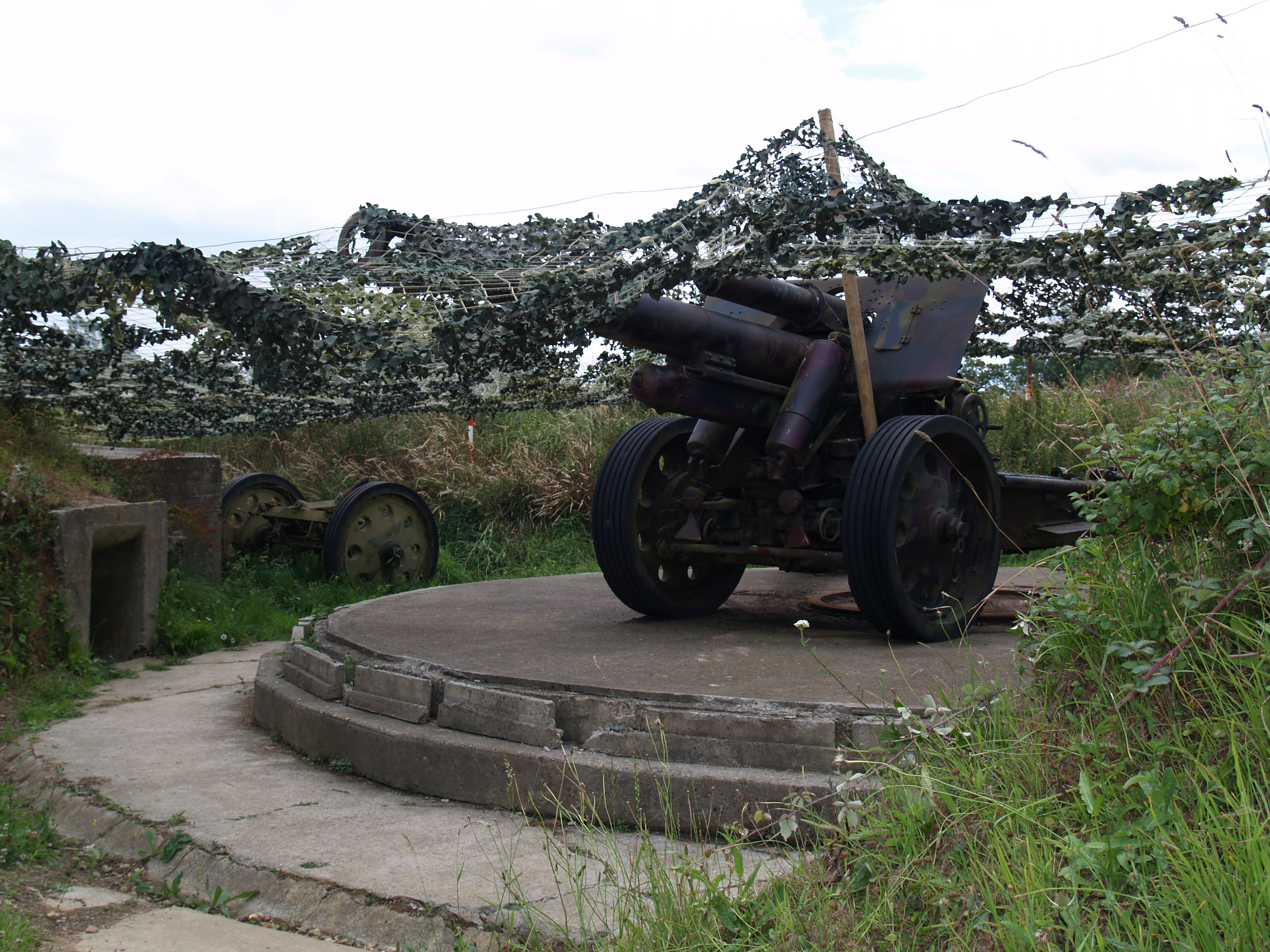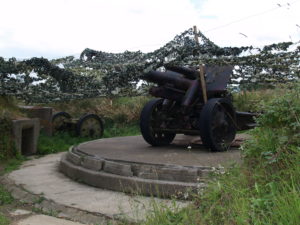Maisy battery
German batteries of the Atlantic Wall in Normandy
15 cm sFH18 gun installed on the Perruques battery in Maisy, coded Stp 83 by the Germans. This gun is not original.
Photo (2010): D-Day Overlord
Unit: 8th and 9th battalions of the 1716th Artillery Regiment (8./AR1716 et 9./AR1716)
Codename: Stp 83 / Stp 84 – H.K.B. Maisy
Artillery gun: 4x 100 mm FH14/19 (t) and 6x 155 mm F414 (f) mm SKC 34
Outcome: Under American control on June 9th 1944
![]() Maisy battery rediscovery debate
Maisy battery rediscovery debate
The Maisy battery is located between the villages of Grandcamp and Maisy in the east, and the mouth of the Vire to the west. It consists of two fortified points (Stp 83 « La Perruque » and Stp 84 « La Martine ») constructed in staggered time and then united by a single minefield as well as by an important network of barbed wire.
Construction and composition of the Maisy battery
The first fortified point in time is that of the locality La Martine (Wn 84 or Stp 84), directed towards the mouth of the Vire. It is armed with four 100 mm FH14/19 (t) guns of Czech origin and a range of ten kilometers, initially installed in open fire positions. With the proliferation of Allied aerial bombardments on the Atlantic Wall, the Germans decided to protect their cannons under shooting casemates: via the Todt organization, they began the construction of four Regelbau H612s, but only three had gone out of the ground And fully operational at the time of disembarkation.
The Stp 84 or « La Martine battery », held by the gunners of 8./AR1716, also includes two 75 mm anti-aircraft guns, five buildings Vf58c and one R622.
Five hundred meters further east is the Stp 83 (Les Perruques battery) defended by 9./AR1716. The Germans installed four open-pit encapsulations to place four fourteen-foot French F414 guns from the First World War, with a maximum range of 11.3 kilometers. Two other guns of the same type reinforce the position, but for want of space they are placed on makeshift positions, dug in the ground.
The Wigs site also includes a tunnel connecting the caves, an underground field hospital and sheet metal shelters, two R622s and a 76,5 mm anti-aircraft gun. Several positions of heavy machine guns are also installed near the battery and near its access routes. In addition, it includes a particularly rare construction on all the installations of the Atlantic Wall: a command and communication post.
The fire command post is located at the edge of the coast, northwest of the town of Grandcamp.
Maisy battery during D-Day
On the night of June 5-6, 1944, the Allies launched a massive air raid over the Atlantic Wall. This is followed at dawn by the naval bombardment issued by HMS Hawkins. Despite this deluge of bombs and shells, no major damage is noted on the site when the American soldiers begin landing on Utah and Omaha, the two nearest beaches of the Maisy battery.
The limit of 155 mm cannons permits the application of lights to the western edge of Omaha beach, in the Vierville-sur-Mer area, and according to the newspaper D-3 of 6 June 1944 drawn up by the 29th The infantry division reported that it was subjected to Maisy’s gun fire on the morning of D-Day. The battery was still active and HMS Hawkins resumed shooting during the day against Stp 83 and Stp 84.
On June 8, General Bradley entrusted a new mission to Colonel Rudder, the commander of the 2nd and 5th battalions of Rangers, who had just captured Pointe du Hoc. This time, it is a question of seizing Maisy’s fulcrum. Rudder, himself wounded, knows that the second battalion is virtually incapable of fighting. He then asked the 5th Battalion, disembarked on Omaha on June 6, 1944, to take charge of the assault.
Three companies of the 5th Ranger Battalion are engaged in the action, supported by two half-tracks of the 2nd Ranger Battalion (armed with 75 mm guns) and by battery B 81st Chemical Mortar Battalion (107 mm mortar army). The Rangers also have four 81 mm mortars.
After the neutralization shot by the 58th Armored Field Artillery Battalion, the Americans set out to assault the extensive site on nearly 44 hectares. According to the testimonies of the veterans, the combats are of extraordinary intensity. The network of trenches is so complex that the Americans get lost several times, adding to the disorder of the battle and causing friendly fire. After five hours of fighting, the battery is under American control.
![]() Back to the German batteries in Normandy menu
Back to the German batteries in Normandy menu


